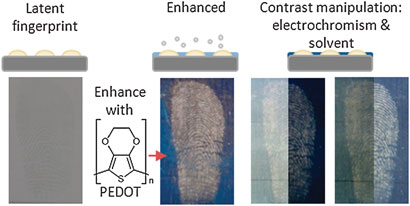Scientists in the UK have developed a method to enhance latent fingerprints on metal surfaces using electrochromism, a process that causes a colour change when a charge is applied.
The type of fingerprints that we are most familiar with from forensic shows on television are called ‘latent’ fingerprints. These are prints that are not visible to the naked eye and need enhancing to be seen, usually with methods such as dusting with powder or fuming with cyanoacrylate (superglue). Unfortunately, these methods do not work so well on metal surfaces and since many crimes nowadays involve metal objects, such as door handles, guns, bullets and knives, for example, it is important to find a technique with a greater recovery rate.
Most latent fingerprints are caused by secretions from one of two types of sweat glands: eccrine glands found on the hands, or sebaceous glands found on the face. In general, fingerprint development techniques rely on the interaction between the chosen reagent and the fingerprint deposit on the surface, such as an amino acid in the sweat. ‘This strategy is vulnerable to loss of fingerprint deposit due to environmental exposure,’ says Robert Hillman from the University of Leicester, who led the research. ‘We adopt a complementary strategy and use the fingerprint deposit as an insulating mask, such that the reagent – an electrochromic polymer – is deposited only on the bare metal surface.’

Scientists can see latent fingerprints on metallic surfaces by depositing the electrochromic polymer PEDOT onto the metal and applying a potential
Hillman and colleagues used a conducting polymer called PEDOT (poly(3,4-ethylenedioxythiophene)) to fill the spaces between the fingerprint ridge details, creating a negative image of the print. PEDOT has electrochromic properties, and by varying the colour and optical density between the fingerprint and the surface using an applied potential, a high level of detail can be achieved.
‘This is an excellent example of a different approach to what is an age-old problem,’ comments Paul Kelly, a synthetic chemist with experience in developing new fingerprint reagents from Loughborough University, UK. ‘Not only does it show promise in itself, it also illustrates how important it is for all strands of chemistry to think how they can potentially address the issue.’
The next step is for the new technique to gain acceptance within the user community, by demonstrating its greater performance against current methods. Hillman also hopes to extend the work to other metals and other electrochromic materials, in effect to design a ‘kit’ for the user so that the right combination of electrochromic material and metal can be used for the best result. He adds: ‘A more interesting prospect is that colour brings a new dimension to fingerprint analysis, since conventional methods involve the analysis of black and white images.’
Electrochromic enhancement of latent fingerprints by poly(3,4-ethylenedioxythiophene)
A. Robert Hillman and Rachel M Brown
Phys. Chem. Chem. Phys., 2012, Accepted Manuscript
DOI: 10.1039/C2CP40733G
Read the original article at Chemistry World










